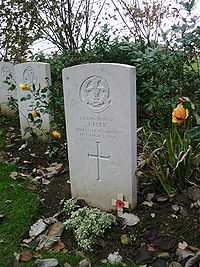John Parr (British Army soldier)
| John Parr | |
|---|---|
|
The grave of John Parr in St Symphorien cemetery | |
| Born |
19 July 1897 Church End, England |
| Died |
21 August 1914 (aged 17) Obourg, Belgium |
| Allegiance |
|
| Service/branch |
|
| Rank | Private |
| Unit | 4th Battalion, The Middlesex Regiment |
| Battles/wars | World War I |
Private John Henry Parr (19 July 1897 – 21 August 1914) was a British soldier. He is believed to be the first soldier of the Commonwealth killed by enemy action in the First World War.
Early years
Parr was born in Lichfield Grove, Finchley, now in the London Borough of Barnet. His father was a milkman. He lived most of his life at 52 Lodge Lane, North Finchley, the youngest of the eleven children of Edward and Alice Parr. [1] Many of his siblings died before their fourth birthday.[2]
On leaving school, he took a job as a butcher's boy, and then as golf caddy at North Middlesex Golf Club. Then, like many other young men of the time, he was attracted to the army as a potentially better way of life, and one where he would at least get two meals a day and a chance to see the world.[3] The 5'3" tall Parr joined the 4th Battalion of the Middlesex Regiment in 1912, aged 15, but claimed to be 18 years and one month old to meet the minimum age requirement. He was nicknamed "Ole Parr", possibly after Old Tom Parr.
Military activity
Private Parr specialised in becoming a reconnaissance cyclist, riding ahead to uncover information then returning with all possible speed to update the commanding officer. At the start of World War I in August 1914 Parr’s battalion was shipped from Southampton to Boulogne-sur-Mer, France. With the German army marching into Belgium, Parr's unit took up positions near a village called Bettignies, beside the canal running through the town of Mons approximately 8 miles (13 km) away. On 21 August, Parr and another cyclist were sent to the village of Obourg, just north east of Mons, and slightly over the border in Belgium, with a mission to locate the enemy. It is believed that they encountered a cavalry patrol from the German First Army, and that Parr remained to hold off the enemy whilst his companion returned to report. He was killed in the ensuing rifle fire.
Fate
Since the British army retreated to a new position around the Marne after the first battle of Mons, Parr's body was left behind. In the ensuing months, the slow entrenchment of the war meant that news of Parr's death was not recognised until much later. After a while his mother wrote to the regiment asking about her son, but they were unable to tell her of his condition, and it may have been that they thought that he had been captured. At the time, there were no dog tags to help with the identification of casualties. The circumstances of his death remain unclear: the front line was approximately 11 miles (18 km) away, and he may have been killed by friendly fire rather than a German patrol,[4] or in the Battle of Mons on 23 August.[5]
Parr is buried in the St Symphorien military cemetery, just southeast of Mons,[6] and his age is given on the gravestone as twenty, the army not knowing his true age of seventeen. Coincidentally, his grave faces that of George Edwin Ellison, the last British soldier killed during the Great War.[7]
On 21 August 2014, the 100th anniversary of Parr's death, a memorial paving stone was ceremonially unveiled in the pavement outside 52 Lodge Lane. The ceremony was attended by about 300 people, including local dignitaries and Parr family members, one of whom read a letter from his mother to the War Office written in October 1914 to enquire about him. A memorial "standing stone" nearby, to bear a plaque with further details of Parr's life and death, is planned. A plaque has also been placed in the golf club where he worked as a caddy.[8][9]
See also
- Henry Hadley, a British civilian, sometimes said to be the "first British casualty" of the war, died on 5 August 1914 after being shot by a German soldier two days earlier.
- HMS Amphion, a British scout cruiser, sunk by a German mine on 6 August 1914, with around 170 killed.
References
- ↑ WWI Centenary: First casualty Private John Parr shrouded in mystery, Barnet & Whetstone Press, 4 August 2014
- ↑ A mother’s anguish over the first man to fall, Daily Telegraph, 3 August 2014
- ↑ Reboul, Percy & Heathfield, John. "First casualty of the war". URL accessed 5 April 2006
- ↑ First British soldier to die in WWI was probably shot in a friendly fire incident by French or Belgians soldiers not German forces as previously thought, Daily Mail, 20 April 2014
- ↑ WW1 mystery: Who killed Private John Parr?, BBC News, 4 August 2014
- ↑ Casualty Details—Parr, John, Commonwealth War Graves Commission. Retrieved on 8 August 2010.
- ↑ John Lichfield, Two soldiers linked in death by a bizarre coincidence, The Independent, 8 November 2008. Retrieved 24 April 2011
- ↑ "Ceremony set to mark centenary of first Great War death". London Borough of Barnet. 18 August 2014. Retrieved 11 January 2014.
- ↑ Theresa Villiers MP. "Finchley teenager remembered 100 years after his death in WWI". Retrieved 11 January 2014. With image of the paving stone.
Further reading
- Baker, Chris. Firsts and lasts
